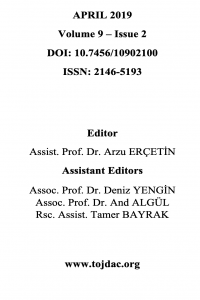Öz
Throughout history, mathematicians from different cultures and places traced other scholars' work to
make a contribution and extend the knowledge of the geometry field. In the Islamic world, artisans
combine the theoretical knowledge about geometry and making skills to build more sophisticated and
complicated geometric patterns. Today, the underlying principles of geometric patterns are still a
research subject of many physicists and mathematicians. Geometric patterns are used both in design
and construction phases of muqarnas which is a specialized spatial element in Islamic Architecture. In
the scope of this study, after a comprehensive analysis, new muqarnas patterns are generated by using
algorithms.
Anahtar Kelimeler
Muqarnas Islamic Geometric Pattern Geometry Algorithmic Design Complexity
Kaynakça
- Abdullahi, Y., & Embi, M. R. B. (2013). Evolution of Islamic geometric patterns. Frontiers of Architectural Research, 2(2), 243-251. Alaçam, S., Güzelci, O. Z., Gürer, E., & Bacınoğlu, S. Z. (2017). Reconnoitring computational potentials of the vault-like forms: Thinking aloud on muqarnas tectonics. International Journal of Architectural Computing, 15(4), 285-303. Al Kashi G.A.D.N. (1977). Key of arithmetics (ed Nablusi N, Arabic edition). Damascus: University of Damascus Press. Arik, M., & Sancak, M. (2007). Turkish–Islamic art and Penrose tilings. Balkan Physics Letters, 15(1), 1-12. Arnheim, R. (1971). Art and Entropy: An Essay on Disorder and Order.Berkeley: University of California Press. Berggren, J. L. (2017). Episodes in the mathematics of medieval Islam. Springer. Castera, J. M. (1999). Arabesques: Decorative Art in Morocco. Art Creation Realisation. Castera, J. M. (2016). Persian variations. Nexus Network Journal, 18(1), 223-274. Crompton, A. (2012). The entropy of LEGO®. Environment and Planning B: Planning and Design, 39(1), 174-182. Cromwell, P. R. (2009). The search for quasi-periodicity in Islamic 5-fold ornament. The Mathematical Intelligencer, 31(1), 36. Dold-Samplonius, Y., & Harmsen, S. L. (2005). The muqarnas plate found at Takht-i Sulayman: a new interpretation. Muqarnas, 22, 85-94. Einstein, A. (1921). Geometry and experience, reprinted in Ideas and Opinions, New York: Bonanza Books. Güzelci, O. Z., Güzelci, H. (2015). An Experimental Study on Generation Process of Geometric Patterns. Proceeding of XVIII Generative Art Conference, Italy. Hankin, E. H. (1905). On some discoveries of the methods of design employed in Mohammedan art. Journal of the Society of Arts, 53, 461-77. Harmsen, S. (2006). Algorithmic computer reconstructions of stalactite vaults-muqarnas-in Islamic architecture. PhD Thesis, Heidelberg University, Heidelberg. Heinrichs, W. (1997). The etymology of muqarnas: some observations. In: Krotkoff G, Afsarudding A and Matias Zahniser AH (eds) Humanism, culture, and language in the Near East: studies in honor of Georg Krotkoff. Warsaw, IN: Eisenbrauns. Hensel, M. (2008). Performance‐Orientated Design Precursors and Potentials. Architectural design, 78(2), 48-53. Houtsma T, Basset R & Arnold TW. (1934). Encyclopaedia of Islam: a dictionary of the geography, ethnography and biography of the Muhammadan peoples. Leiden: E. J. Brill. Kant, I. (1998). Critique of pure reason. Cambridge University Press. Krampen, M. (1979). Meaning in the urban environment, Pion. London, UK. Klinger, A., & Salingaros, N. A. (2000). A pattern measure. Environment and Planning B: Planning and Design, 27(4), 537-547. Lu, P. J., & Steinhardt, P. J. (2007). Decagonal and quasi-crystalline tilings in medieval Islamic architecture. science, 315(5815), 1106-1110. Penrose, R. (1979). Pentaplexity a class of non-periodic tilings of the plane. The mathematical intelligencer, 2(1), 32-37. Osserman, R. (2011). Poetry of the Universe. New York: Anchor. Ödekan, A. (1977). Osmanlı Öncesi Anadolu Türk Mimarisinde Mukarnaslı Portal Örtüleri. İTÜ Mimarlık Fakültesi Baskı Atölyesi, İstanbul. Özdural, A. (1990). Giyaseddin Jemshid el-Kashi and Stalactites. Middle East Technical University, Journal of the Faculty of Architecture, 10, 34-35. Özdural, A. (2000). Mathematics and arts: Connections between theory and practice in the medieval Islamic world. Historia mathematica, 27(2), 171-201. Shannon, C. E. (1949). Communication theory of secrecy systems. Bell Labs Technical Journal, 28(4), 656-715. Stamps III, A. E. (1998). Complexity of architectural silhouettes: from vague impressions to definite design features. Perceptual and motor skills, 87, 1407-1417. Stamps III, A. E. (2004). Entropy and visual diversity in the environment. Journal of Architectural and Planning Research, 239-256. Terzidis, K. (2003). Expressive Form: A conceptual approach to computational design. Taylor & Francis. Url-1: https://en.wikipedia.org/wiki/Geometry Url-2: https://en.wikipedia.org/wiki/Topology Url-3: https://en.wikipedia.org/wiki/Iconoclasm Url-4: http://shiro1000.jp/muqarnas/ Url-5: http://muze.semazen.net/content.php?id=00066
Ayrıntılar
| Birincil Dil | İngilizce |
|---|---|
| Bölüm | Makaleler |
| Yazarlar | |
| Yayımlanma Tarihi | 1 Nisan 2019 |
| Gönderilme Tarihi | 10 Ocak 2019 |
| Kabul Tarihi | 25 Mart 2019 |
| Yayımlandığı Sayı | Yıl 2019 Cilt: 9 Sayı: 2 |
All site content, except where otherwise noted, is licensed under a Creative Common Attribution Licence. (CC-BY-NC 4.0)


